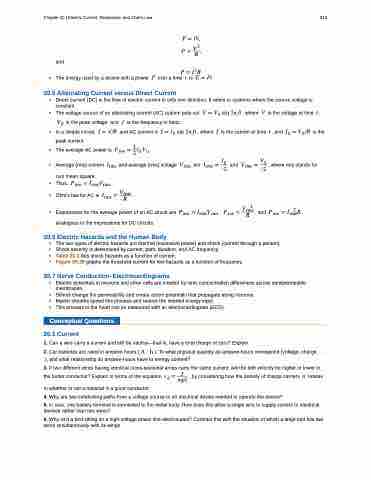Page 925 - College Physics For AP Courses
P. 925
Chapter 20 | Electric Current, Resistance, and Ohm's Law 913
� � ��� � � ���
• Direct current (DC) is the flow of electric current in only one direction. It refers to systems where the source voltage is constant.
• The voltage source of an alternating current (AC) system puts out � � �� ��� �� �� , where � is the voltage at time � , �� is the peak voltage, and � is the frequency in hertz.
• In a simple circuit, � � ��� and AC current is � � �� ��� �� �� , where � is the current at time � , and �� � ���� is the peak current.
• The average AC power is ���� � ���� �� .
• Average (rms) current ���� and average (rms) voltage ���� are ���� � �� and ���� � �� , where rms stands for
and
• The energy used by a device with a power � over a time � is � � �� .
20.5 Alternating Current versus Direct Current
root mean square.
• Thus, ���� � �������� .
• Ohm's law for AC is ���� � ���� . �
��
• Expressions for the average power of an AC circuit are � analogous to the expressions for DC circuits.
20.6 Electric Hazards and the Human Body
���
� �
� , � ��� ���
���
�
��
��� , and �
���
� �
� � , ���
• The two types of electric hazards are thermal (excessive power) and shock (current through a person).
• Shock severity is determined by current, path, duration, and AC frequency.
• Table 20.3 lists shock hazards as a function of current.
• Figure 20.28 graphs the threshold current for two hazards as a function of frequency.
20.7 Nerve Conduction–Electrocardiograms
� � � ����
• Electric potentials in neurons and other cells are created by ionic concentration differences across semipermeable membranes.
• Stimuli change the permeability and create action potentials that propagate along neurons.
• Myelin sheaths speed this process and reduce the needed energy input.
• This process in the heart can be measured with an electrocardiogram (ECG).
Conceptual Questions
20.1 Current
1. Can a wire carry a current and still be neutral—that is, have a total charge of zero? Explain.
2. Car batteries are rated in ampere-hours ( � � � ). To what physical quantity do ampere-hours correspond (voltage, charge, . .
.), and what relationship do ampere-hours have to energy content?
3. If two different wires having identical cross-sectional areas carry the same current, will the drift velocity be higher or lower in
the better conductor? Explain in terms of the equation �� � � , by considering how the density of charge carriers � relates ���
to whether or not a material is a good conductor.
4. Why are two conducting paths from a voltage source to an electrical device needed to operate the device?
5. In cars, one battery terminal is connected to the metal body. How does this allow a single wire to supply current to electrical devices rather than two wires?
6. Why isn't a bird sitting on a high-voltage power line electrocuted? Contrast this with the situation in which a large bird hits two wires simultaneously with its wings.
�


